#genge rap
Explore tagged Tumblr posts
Audio
(AKATA GENG GENG) THE RICHEST MAN BEAT
1 note
·
View note
Text
BP - Mission 1
okay. watching the practice session then the youtube full performance. THEN i'll go back and watch the episode shit.
..............................................................................................................................

K-Group: LEE HWAN HEE (26, 5'9")/F/P/P - ew, also the Daewon knock off did NOT hit that note. HAN YU SEOP (20, 5'8")/F/?/F - I'mma pass them all except the one in the Johnny Cherry Bomb bib HONG KEON HEE (19, 6'2")/P/P/P - the one in the black shirt is fine at rapping JANG YEO JUN (19, 5'10")/F/P/P PARK GUN WOOK (19, 6'0")/P/P/P - okay so he's such a cutie. please take care of him. (also him shaking while saluting,,, omooooo.)
G-Group: KEITA (23, 5'5")/F/F/P - okay the one with White Sleeves was fine at rapping CHEN KUAN JUI (23, 5'9")/F/F/F MIN (24, 5'9")/P/P/F SEOK MATTHEW (22 5'7")/P/P/P - and the one with the red shit on his fingers and tie was good at vocals WANG ZI HAO (23, 5'10)/F/P/F ZHANG HAO (24, 5'11")/F/P/P - the one with the lace-up glove was fine too
Um, to be fair WANG ZI HAO (23, 5'10)/F/P should have gotten the Killing Part based on that nonsense they did.
[he's so overlooked it's criminal]
ZHANG HAO (24, 5'11")/F/P is the correct choice for main vocal
SEOK MATTHEW (22 5'7") - boys smiles too damn much. It's okay to show your upset boo boo!
ohhh PARK GUN WOOK (19, 6'0") is cutely cocky! I mean, he's not wrong though!
omfg, LEE HWAN HEE (26, 5'9"), Daewon knock off goes "I'm just Gunwook's puppet" UM GIRL SAME.
And awwwww PARK GUN WOOK (19, 6'0")-ie giving the other kid song prompts in the dance so he'd remember!
NOOOOOO, not PARK GUN WOOK (19, 6'0")-ie crying!!! TT
awwwww, MIN (24, 5'9")/P/P/F went to go stand in the corner!
.........................................................................................................................

Girl, I am just WAITING for the voice cracks on this song.
K-Group: CHA WOONG KI (22, 5'8")/F/F/F JANG JI HO (20, 5'8")/P/F/F JUNG MIN GYU (24, 6'1")/F/F/F LEE DONG YEOL (25, 5'9")/F/F/F MUN JUNG HYUN (19, 6'0")/F/P/F SEO WON (23 5'7")/F/F/F YOO SEUNG EON (20, 5'10")/F/P/F naur, only the main vocal one did semi decent but only cause his voice didnt crack on the high note.
LEE DONG YEOL (25, 5'9") - he's handsome!
G-Group: HIROTO (22, 5'9")/F/F/F CCONG (23, 5'8")/P/P/F ICHIKA (31, 6'0")/F/F/F MA JING XIANG (20, 6'2")/F/F/F OUJU (20, 5'7")/F/F/F WEN YE CHEN (24, 6'0")/F/?/F YUKI (22, 5'8")/P/F/F
Oh they all really went head-to-head huh? well, i dont remember and I'm not going back to watch.
...........................................................................................................................

K-Group: LEE DA EUL (20 5'7")/F/F/F CHOI JI HO (20, 6'0")/F/P/F JEON WOO SEOK (21, 5'8")/F/F/F JEONG I CHAN (23, 5'10")/P/F/F KIM MIN HYUK (25, 5'11")/P/F/P - none of em were good. but i'll pass the one with the short-sleeve blazer cause he WAS the team LEE SEUNG HWAN (24, 5'10")/P/P/P - and the rapper with the blazer LIM JUN SEO (19, 5'10")/F/F/F
G-Group: CHEN YU GENG (26, 6'0")/P/?/F DONG DONG (23, 5'9")/F/F/F ITSUKI (18 5'7")/F/F/F TAKUTO (16, 5'5")/F/F/F WANG YAN HONG (25, 5'10")/F/F/F YANG JUN (25, 5'9")/F/F/F YUTO (19 5'7")/F/F/F
oh naurrrrr naurrrr naur.
.....................................................................................................................

K-Group: KIM JI WOONG (25, 5'10)/P/P/P HAN YU JIN (17, 5'10")/F/P/P JI YUN SEO (19, 6'0")/F/P/P - the tall kid with big ears was borderline, but no one stood out as horrible. KIM MIN SEOUNG (20, 5'8")/P/P/P KIM TAE RAE (22, 5'8")/F/P/P KUM JUN HYEON (22, 5'11")/F/P/P YOON JONG WOO (24, 5'9")/F/P/P
KIM JI WOONG (25, 5'10)/P/P seems chill? plus he's cute comforting that other kid. I just googled it, he's the BL actor.
I mean it was fine. They all get passes.
HAN YU JIN (17, 5'10")/F/P/P - all this kid does is fuck up and cry and whine. HOW did he get into ZB1?? Like??? fuck that. He's not even good in ZB1 and his attitude is piss poor. "If there's a member thats ruining the performance, it's you" - still accurate.
G-Group: RICKY (20, 6'0")/F/F/F - this bitch has to cover his tattoo every damn day? *eyeroll* BRIAN (22, 6'1")/F/F/F CHEN JIAN YU (26, 5'10")/P/?/F FENG JUN LAN (25, 5'10")/P/F KRYSTIAN (24, 5'10")/P/?/F NA KAMDEN (23, 6'0")/F/P/F ZHANG SHUAI BO (22, 6'0")/P/F/F
So is KRYSTIAN (24, 5'10")/P/? really a dick or did he get an MNet edit?
Awwwww, they got NA KAMDEN (23, 6'0")/F/P crying! :/ There must have been SOME truth to it! eff you followers.
So I've decided. I'm Team KRYSTIAN (24, 5'10"). I think he was unjustly evil edited and NA KAMDEN (23, 6'0") is a whiney baby. And that's proven throughout other episodes too. yes, it's frustrating, but he took it to a place he didn't need to take it.
RICKY (20, 6'0")/F/F has the ability to both look boring as hell yet charismatic at the same time.
Honestly trainer bro, eff you. KRYSTIAN (24, 5'10") looks feminine and uncharismatic? fuck all the way off with that.
.........................................................................................................................

K-Group: CHOI SEUNG HUN (16, 5'7")/F/F/F JEON HO YOUNG (19, 5'10")/F/P/F JUNG HO JIN (21, 6'0")/F/F/F JUNG SE YUN (16, 5'8")/F/F/F PARK GWAN YOUNG (23, 5'7")/P/P/P - the only one I'm passing is the older one with the bolero tie in the white. PARK MIN SEOK (22, 6'0")/F/P/F
WHO PUT this angel baby on a show like this? CHOI SEUNG HUN (16, 5'7")/F/F
G-Group: YUTAKA (25 5'7")/F/?/F CHEN REN YOU (20, 6'0")/F/F/F HYO (22, 5'8")/F/F/F KEI (18 5'7")/F/F/F QIU SHENG YANG (23, 5'10")/F/F/F RIKU (19, 5'11")/F/F/F XUAN HAO (28, 5'11")/F/F/F
..........................................................................................................................

K-Group: LEE DONG GUN (19, 5'10")/F/F/F BAK DO HA (21, 5'11")/F/F/F CHOI WOO JIN (19, 5'7")/P/P/F PARK HAN BIN (22, 5'9")/F/P/P - the only one I'm passing is the sleeveless one. PARK HYUN BEEN (19, 5'10")/F/P/F PARK JI HOO (18, 5'9")/F/F/F
okay this baby PARK JI HOO (18, 5'9")/F/F is cuuuuuute.
wait, how did PARK HAN BIN (22, 5'9") end up on this team??
G-Group: NICE (24, 5'11")/F/F/F CAI JIN XIN (20, 6'2")/F/F/F CHEN LIANG (24, 6'1")/F/F/F LIN SHI YUAN (25, 6'0")/F/F/F OLLIE (18, 6'0")/F/F/F OSUKE (21, 5'4")/F/F/F TOUI (21, 5'11")/F/?/F
...................................................................................................................

K-Group: HUI (31, 5'7")/P/P/P HAN SEO BIN (18, 5'8")/P/F/P KIM GYU VIN (20, 6'0")/F/P/F LEE JEONG HYEON (22, 6'1")/F/P/F LEE YE DAM (21, 5'5")/F/P/P OH SUNG MIN (23, 5'11")/P/F/P SUNG HAN BIN (23, 5'10")/P/P/F
okay but OH SUNG MIN (23, 5'11")/P/F over here acting like the leader
HUI (31, 5'7")/P/P doing too much though and it doesn't match the group :/ Like take it down 3 notches. Idk man. I'mma pass him though.
yeah KIM GYU VIN (20, 6'0") struggling. I've said it 100x. He's NOT good.
G-Group: DANG HONG HAI (20, 5'11")/F/F/F - failing knock off hansol ANTHONNY (20, 5'8")/F/P/F HARU (18, 5'6")/F/P/F HARUTO (19, 5'7")/F/P/P JAY CHANG (23, 5'9")/P/P/P WINNIE (25 5'7")/F/F/P WUMUTI (25, 5'9")/P/F/F
I'm liking WUMUTI (25, 5'9")/P/F alot more here than in Build Up. Here he seems real and in Build Up he seemed fake. Like not even real cunty, like put on cunty.
hahaha, omfg HUI (31, 5'7")/P/P "It's K-pop, but he's singing Pop." Um, who's gonna tell him?
haaaaaaaaaaa, the judges being in love with JAY CHANG (23, 5'9")/P/P/P. GIRL, SAME!
omggg, WUMUTI (25, 5'9")/P/F is so cute in the backround when they say the other kids ears are red!
also fr though, how CAN JAY CHANG (23, 5'9")/P/P/P sing like that while dancing? And how did he not win this whole damn competition?? AND HOW DID HE ONLY GET 66??
------------------------------------------------------------------------------
Wait, how did they pick which ones arm wrestled?
0 notes
Text
Rema, Yemi Alade, Tayc, Davido… Here Are All The Winners Of The First-Ever Trace Awards

Global music powerhouse and Afro-music tastemaker, Trace held its inaugural Trace Awards 2023 on October 21, 2023, at the BK Arena in Kigali, Rwanda, to celebrate the creativity, talent, and influence of African and Afro-inspired music and artists. More than 150 artists were nominated in the awards ceremony, which showcased the excellence and diversity of Afro-centric music in genres such as Afrobeat, Dancehall, Hip Hop, Afro-pop, Mbalax, Amapiano, Zouk, Kizomba, Genge, Coupé Décalé, Bongo Flava, Soukous, Gospel, Rap, Rai, Kompa, R&B, and Rumba. The awards ceremony, which was hosted by Nigerian music veteran D’Banj alongside Angolan global supermodel Maria Borges, featured a star-studded lineup of performers, including Davido, Yemi Alade, Black Sherif, Kizz Daniel and more. This year’s nominees included stars like Davido, Burna Boy, Blxckie, Yemi Alade, Libianca, and DJ Maphorisa, among others. If you weren’t able to tune in, here are the winners of the Trace Awards 2023. - Best Music Video – “Baddie” Yemi Alade (Nigeria) - Best Artist France & Belgium – Tayc (France) - Best Producer – Tam Sir (Ivory Coast) - Best Artist North Africa – Dystinct (Morocco) - Best Artist UK – Central Cee - Best Artist Indian Ocean – Goulam (Comoros) - Best Artist Francophone Africa – Didi B (Ivory Coast) - Best DJ – Michael Brun (Haiti) - Best Gospel Artist – KS Bloom (Ivory Coast) - Best Artist The Caribbean – Rutshelle Guillaume (Haiti) - Best Artist Anglophone Africa – Asake (Nigeria) - Best Global African Artist – Rema - Best Newcomer – Roseline Layo (Ivory Coast) - Best Collaboration – “Unavailable” – Davido (Nigeria) with Musa Keys (South Africa) - Best Dancer – Robot Boii (South Africa) - Best Artist Lusophone Africa – Lisandro Cuxi (Cape Verde) - Changemaker Trace Award – Mr Eazi (Nigeria) - Best Live – Fally Ipupa (DRC) - Lifetime Achievement Award – 2Baba (Nigeria) - Album of the Year – “Love Damini” – Burna Boy (Nigeria) - Best Female Artist – Viviane Chidid (Senegal) - Best Male Artist – Davido (Nigeria) Read the full article
0 notes
Text
MP7 DA RAPPER RELEASES AMAZING EP- JESUS GENG
He is one rap artist who is versatile and believes so much in the power of words. He has performed on platforms alongside top Gospel artists and this year he dishes out his EP titled JESUS GENG. The EP features amazing music acts; Dove Squad and Abuja’s finest DJ, DJ Ernersty. Jesus GENG the EP has some very deep and relateable messages for the youths globally. It’s a 6 track compilation and…

View On WordPress
0 notes
Text
[EP] Jesus Geng – Rapper MP7

Ultimate Akpenyi who is popularly known as MP7 Da Rapper has finally released his first EP project since he switched into the Gospel music industry. He is one rap artist who is versatile and believes so much in the power of words. He has performed on platforms alongside top Gospel artists and this year he dishes out his EP titled JESUS GENG. The EP features amazing music acts; Dove Squad and Abuja’s finest DJ, DJ Ernersty. Jesus GENG the EP has some very deep and relatable messages for the youths globally. It’s a 6 track compilation and every song on the EP is a masterpiece. Enjoy this amazing body of work. Jesus Geng – Rapper MP7 https://youtu.be/FNQwv5nG9sY https://open.spotify.com/album/0o6WdfFE207mGKKcSCPssr?si=0K7Csz0QTHW5DKR-Iw787g Read the full article
0 notes
Text
[EP] Jesus Geng - Rapper MP7
Ultimate Akpenyi who is popularly known as MP7 Da Rapper has finally released his first EP project since he switched into the Gospel music industry. He is one rap artist who is versatile and believes so much in the power of words. He has performed on platforms alongside top Gospel artists and this year he dishes out his EP titled JESUS GENG. The EP features amazing music acts; Dove Squad and…

View On WordPress
#AfroBeat Song#AfroGospel#AfroGospel Music#Afrogospel Song#Amapiano Gospel#Rapper MP7#Urban Gospel#Urban Gospel Music#Urban Gospel Song
0 notes
Audio
(Afrobeats Update 2021) Afrobeats Update #5 - Gengetone, New Sounds of Kenya (April 2021) TRACKLIST Femi One feat. Mejja - Utawezana Benzema feat. Ssaru - Utawezana Remix Nyashinski feat. Chris Kaiga - Hapo Tu Kansoul & Vivian - Accelerator (Serereka) KrgTheDon feat. Boondocks Gang & Dj Lyta - Mathogothanio E.Que feat. Gurnza and Dark - Chuma Ya Doshi Mejja - Siskii (Kamote) Femi One - Mikiki Odi Wa Muranga feat. States - Kinyambiz Breeder LW feat. G-Chess, Alma & Collonizzo - Denri Boondocks Gang & Kansoul - Hainishtui Boondocks Gang feat. Joefes & Iphoolish - Vuvuzela Maandy feat. Exray, Dyana Cods & Breeder LW - Pon It Benzema - Ngwatiology Exray feat. Rekles, Zzero, Kristoff, Scah Mkadinali - Disco Matanga Joefes feat. Mejja & Mbuzi Gang - Shamra Shamra Willis Raburu feat. Rekles, Breeder LW, Mejja & Ssaru - Kalale Matata - Mare Mare Mbogi Genje feat. Exray - Kuja Mbaya Matata - Kata Mbogi Genje - Ngumi Mbwegze Cytah YungEro feat. Maandy - Kifua Joefes & Fathermoh feat. Swat, Exray, Ssaru, Dullah, Mbuzi Gang - Wagithomo Exray feat. Dj Deklack, Tileh Pacbro, Pitah Scarlet, Shornarway - Stingo D.More, Seska, Kappy & Parroty - Nyonya Rekles & Highgrade - Stiki Rico Gang feat. Kartelo - Kimonyoski Ssaru & Mejja - Leo Trio Mio feat. Mejja, Exray & Nellythegoon - Cheza Kama Wewe Remix
#SoundCloud#music#Afrobeats Update 2021#Dancehall#Hip Hop#Kenyan Rap#Afrobeats#gengetone#genge#genge rap#afrorap#afrohiphop#mejja#kansoul#ssaru#femi one#mbogi genje#maandy#mbuzi gang#boondocks gang#trio mio#rekles#rekless#benzema#matata#exray#zzero#kristoff#joefes#dyana cods
5 notes
·
View notes
Note
hi! swf anon here
i agree w ur points. i don’t think the mission was very fitting? mnet had them essentially do an individual mission but mix matched the crews together and do a Group performance… in the episode, no one really cared to work together. instead they were more focused on wanting to stand out. i thought all the performances were v lackluster so i���m hoping for more? but my expectations are VERY low because the preview dance performances for the next ep looked v bad. each crew has more dancers to fill space and do fun formations but like, also? it seemed v poorly produced (stage design is literally them in a big ass empty stage). and that more doesn’t mean better because some stages looked v disorganized.
also, it seems like the show is more focused on ‘idol dancing’ if that makes sense? and that’s why it’s shot and edited that way. because chaeyeon is on it, there has been a lot of discussion of what counts as dancing vs idol dancing. also if idols can be considered as dancers. (the same argument that idol rappers are not rappers, etc.) taeyong was thrown in the mix because he’s one of the judges and people don’t think he’s Valid to be one.
also, what is unique to street battle dancing? i’m not familiar w it. and honestly i feel like boa is the only one making sense on the show. i like her comments and why she chose a crew as the better performance.
(this is a jumble of thoughts! sorry. i’m not on my laptop.)
no worries at all! your jumble makes perfect sense to me. i''m sorry this got very long and is mostly me rambling, i guess it's tit for tat at least!
honestly i would rather them doing big groups on an empty stage than whatever those massive quarry sets were, because at least we'll be able to see the choreo a little better. and you're absolutely correct more does not at all mean better. i am definitely a little confused on the priorities of the show, since they seem to be trying to incite the dance vs kpop dance conversation but don't actually seem to be doing it in a constructive way? i haven't watched the full episodes so i can't confirm, obviously, but from what i've seen they mostly just seem to be fueling the division between the two. i talked about this with the idol rapper thing during the collab kingdom stages but idol dance serves exactly the same function as idol rap; it's a part of the form of idol performance. it is a type of dance, and there are certainly idols who are very good at dance, but idol dancers and idol dance is not pushing or innovating the art of dance as a field. it's simply a different set of skills that serve a different function in a different form of art. it's kind of like trying to ask a fashion designer to be a performance costume designer. yea, ostensibly it's the same skills that came from the same place, and yes there are people that can do both, but they are specialized for their specific fields.
personally, of any current popular idol they could have picked, i think taeyong is a better choice than most. he's got a very well known face, he's a leader so he's used to being variety show material, and although he does dance like an action figure animated by suspicious mystical forces, he does actually care a lot about learning and acquiring new skills (see the fish surgeon incident), so he's not about to go onto the show wholly unprepared. not saying he's going to provide the most helpful feedback, but he's probably gonna be better than some other idols they could have picked, at least. and honestly? from what i've seen so far, i don't actually think there's a lot of dance happening that i would consider not idol dance, so i think it's probably fine that 2/3 judges are idols.
like i said in the tags of my previous post, battle dancing + street dance in general are much more focused on technique than idol dancing is. also most of it is freestyle. it's about arranging moves in combination to music in a fresh and interesting way that has a good structure and strong musicality. i linked the final from battle pro 2019 in my first post, but it's a little hard to explain what's going on, so instead i'm going to use mostly battle examples from street dance china here, because it's also a show about street dance that uses idols/celebrities as a way to bring in viewers, but they are also bringing in judges and dancers active in the global street dance scene.
this is one of my favourite battles from season 3, it's one round from a 4v4 where each dancer is trying to garner points for their team to avoid an elimination. the great thing about this battle is that it shows the strengths and weakness of different styles in battle dancing. this particular music works very well for two of these dancers, chunlin (second) and bouboo (fourth), but it doesn't work that well for klash (third), who is a bboy. you can also see how the editors of sdc actually put in post all the different moves that each dancer is doing, which i think is great and shows all the bits of technique that come together for each freestyle.
this is a 3v3 from the fourth season, where the first round is hiphop, second round is bboy, and third round is waacking (there are two other rounds after, but they cut rochka v bouboo from this edit and only showed c lil v qiao zhi, the bboys). the first round is VERY close to a draw, and rochka (long dreads) actually beats bouboo in the second round (bouboo is rochka's teacher, they're both french hiphop champions). qiao zhi beats c lil in the bboy rounds because he focuses more on technique and listening to the music, as opposed to doing just showy and experimental moves (you can see qiao zhi gesturing at his ears in the second round at the end, saying that c lil isn't listening). and in the waacking round, ac goes a little more for showmanship than technique, and that's why ibuki beats him in the end. tony gogo does a short explanation that says basically this, who is one of the judges and is a founder of the first locking group in the 70s, and also one of michael jackson's choreographers.
if you want to watch something that's a bit more showy and actually uses the idols, this is the first round of the captain's battle between wang yibo (uniq) and jackson wang (got7) from sdc3, where they have like 15min to come up with a short choreo to the same piece of music and then have to battle each other with it. and this is basically the same thing from sdc4, but the captains had to pick a dancer to dance with. the rules were slightly different for this one so the captain could chose to have another dancer sub, which is what han geng did for his second round. if you have 20 min and are curious, this is the full captain's cypher also from sdc4, which is han geng (ex-suju m) v zhang yixing (exo) v wang yibo v henry lau (ex-suju m). they're battling for extra towels (long story, it's the point system, basically) to save dancers that have already been eliminated. each of them pick a style they want to dance, and they have to do four rounds and all dance to each style's music.
basically what i'm using all these examples to explain is that battle dancing is about having a really strong understanding of basic dance skills and being able to do good freestyle. that's the biggest difference between idol dancers and street dancers. and this also extends beyond battles as well; here's another example because i can and because it's extremely funny. this is from the first elimination round in sdc4, where half the dancers were able to pre-choreograph performances and were only able to challenge them in a call out, but the caveat was that they HAD to dance to the other dancer's music without listening to it again. so basically if you wanted to call out someone, you had to listen and memorize while watching their routine, and then freestyle a routine on the spot. which meant that everyone who pre-choreographed routines did it to the most batshit music they could possibly think of, to prevent people from challenging them. xiao ji calls out welllai because he's a dumbass and wants to go to the bathroom, so you can actually see his thinking process in trying to freestyle to this weirdass fuckin beat she used. and he ultimately wins the call out because he shows good ingenuity and character as well as technique and ability. he even says at the end that it was only because of many years of practice that he was able to pull that off.
#street woman fighter#swf#honest to god my second favourite thing about sdc is watching yibo go absolutely fucking FERAL during the battles#he's usually pretty introverted and focused but just loses his fucking shit every time it's so funny#in the seven to smoke battle (1v7) in sdc3 he actually throws a chair at one point#(my first favourite thing is the dancing obvs) (third favourite is the idiom competitions)#xiao ji and also xiao jie (the first dancer from the first battle example) are both probably the best comedic dancers ive ever seen#both of them were part of steven chow themed routines in sdc3 and holy shit they are so funny#xiao ji gotta be funny his name is a synonym for 'little chicken'#sdc#text#answers#swf reviews#me making myself crosseyed trying to remember everyone's names because they all used their chinese names#i spent four months calling jackson wang jiaer and it erased my memory of ever calling him jackson. qiao zhi's stage name is george#he does look like a george but im not calling him that#its also why i stopped refering to yixing as lay#yibo took one look at bouboo in the third season and went 'thats MY man' and no one stopped him#they barely have a mutual language its so cute#and yixing and his attachment to huang xiao and qiao zhi.....also very cute#sdc is the only competition show i care about can you tell#ok im stopping now im going overboard
9 notes
·
View notes
Text
Street Dance of China Season 4, Episode 5
- I love practice montages! I was surprised that we got to see the process of each of the captains (of the competing teams) choosing dancers to their teams. Ibuki and Ma Xiaolong were speaking English to each other, and I don’t doubt that English was probably the main mode of communication across borders for these dancers.
- Okay Ibuki leading Huang Xiao by hand and then Huang Xiao cackling in glee and hugging Ma Xiaolong....very cute.
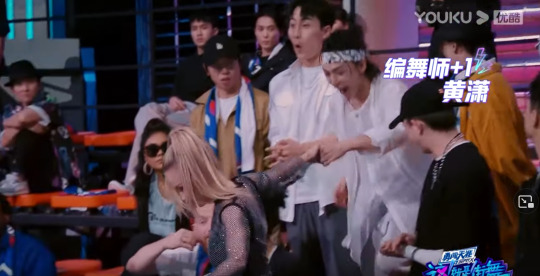
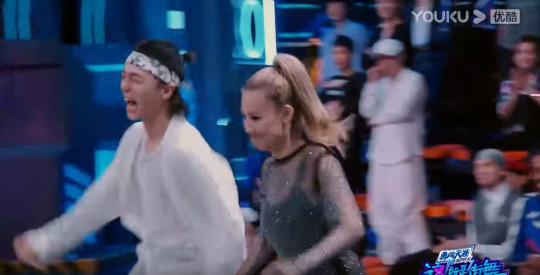
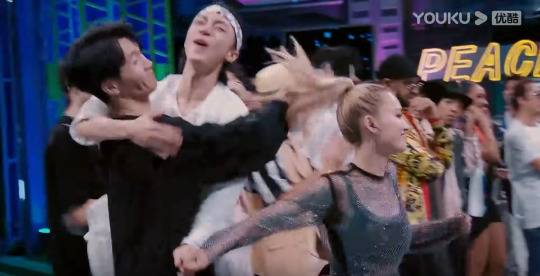
- So...is Huang Xiao baby?

- Huehuehue love Poppin’C’s laugh
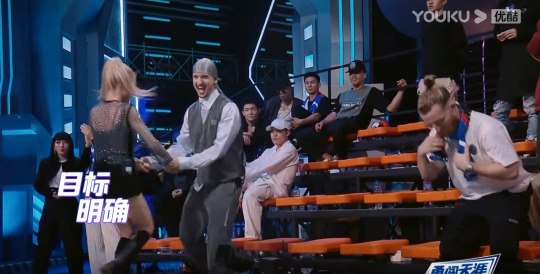
- Ibuki said that Ma Xiaolong helped her a lot with recruitment. I think that’s for two reasons. One is that Ma Xiaolong (and Huang Xiao) are choreographers, so they have a better idea of what styles look together. The other is that Ma Xiaolong knows the Chinese dancers better than she would.
- Moony was saying how Ibuki is the captain but she is the youngest, and is definitely very cute haha.
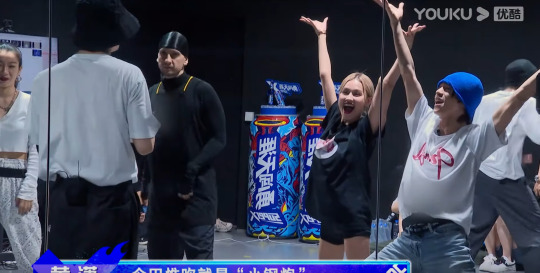
- Yang Kai was very worried about dancing to a rap song so he recruited as many choreographers as he could. But the issue was that they all had different approaches to choreographing so they spent a lot of time discussing before choreographing and rehearsing.
- Yang Kai deadass brought his laptop to the hotpot restaurant because he was going to turn dinner into a lesson on Three Kingdoms for Boris and Kenken lol. The name of their song was Chitu, which is the horse of Lv Bu. Basically Chitu was just a great super capable horse and that’s why it was so famous lol. Yang Kai was trying to compare their battle to the Three Kingdoms lmao. Kenken was Zhuge Liang, Ibuki was Cao Cao (LMAO), and Chitu Ma was a Ferrari lol. Not gonna lie though, the stories in Three Kingdoms are pretty iconic lol.

- In terms of the performances, I liked them both! I think that Team Ibuki’s performance was very fun in the sense that it was like a story. I don’t think songs like that are popular dance songs, so I really liked seeing how they choreographed the dance and I felt that it was done in a very creative and fun way. I think where it may have fallen short was the cohesion. I like Poppin’C, but I wonder if it was difficult to fit him in because his skill set was so specific. As well, because all of the dancers were wearing different clothes, it was a bit difficult to see their synchronization during the group dance parts. For Team Yang Kai’s performance, it definitely was extremely hype. Whereas Team Ibuki wore different clothes, Team Yang Kai had a dress code so the cohesion was easy to see. But I feel like Team Yang Kai’s performance was being propped up by the fact that it had a very hype song, one that easy to dance to.
- Rochka continues to be the biggest fanboy of every single person on this show. I love him!!!
- Y’all have no idea how much I love hearing Boris speak Chinese. Yes, he has an accent, but he is also very easy to understand. You have no idea how difficult it is to find non-ethnic Chinese people who speak Chinese this fluently. Iunno, he just makes Mandarin seem so much more approachable. Boris said that he’d been in China for 7 years so it makes sense that he feels so confident speaking. A lot of people who are learning languages have to get over that hump where they stop feeling embarrassed about their accent because they have to go out and live their life and buy groceries and go to the doctor and stuff and it’s really interesting to hear Boris expressing himself.
- Henry feeling so pressured when he had to choose which team to pick lmao.
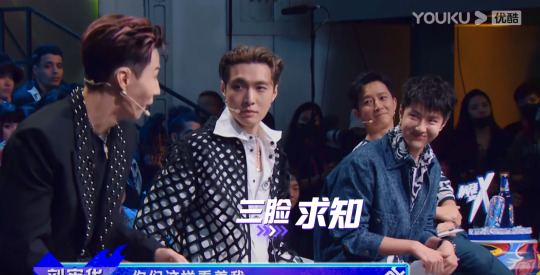
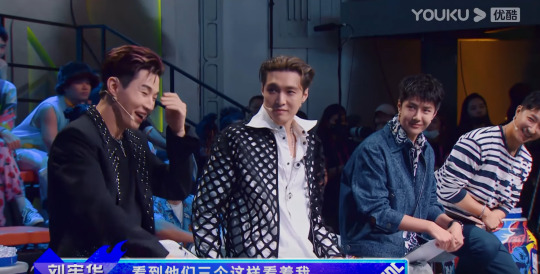
- Yixing went “We’re looking at you because you’re cute!” So bold, Yixing XD

- And Henry went “I feel pressured because you guys are handsome.” XD Two can play at that.
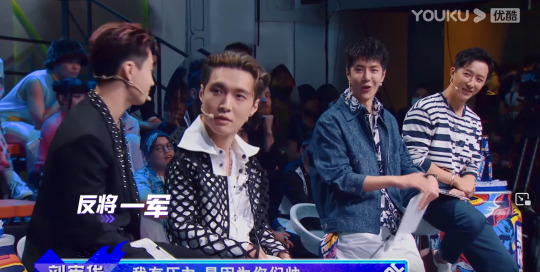
- Then Han Geng went “Henry’s Chinese is so good now!” XD My mom says that to me when I make a good joke in Chinese.
- Yixing has to talk behind his clipboard because he’s so nervous lmfao.
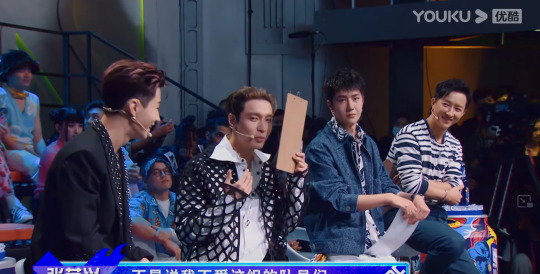
- So the rule is that one judge gets two votes for each matchup. In addition to that, that judge has to cut three members, two to enter a battle and one to be eliminated immediately, not including the captain.
- Ibuki was so upset when she returned to her seat :(
- Ye Yin had his team draw out their feelings as they listened to their assigned song. I thought it was a bit gimmicky, but this visual is cute.
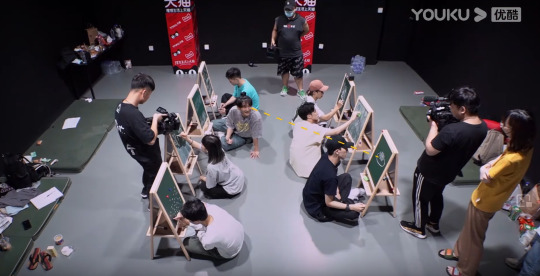
- I thought Team Ye Yin’s performance was cool considering this was a song that would be difficult to choreograph for. I was surprised with how the incorporated breaking and locking elements, as there are breaking and locking experts on their team. But overall I thought the choreography was so nice. It told a story, and it suited the vibe of the song. Props to Bunta for the awesome choreography.
- Han Geng said that their performance reminded him of his youth, and then Henry said that he felt the same, that the performance reminded him of Geng-ge. He was like “ge, do you remember?“ and Geng-ge was like of course! Han Geng said he remembered their romantic days X’D So unnecessary. At one point the director was like did Han Geng and Henry used to have their arms around each other’s shoulders? And both of them were like uhh yeah all the time dude.
- George was asked about his rivalry with C-Lil because they keep getting stuck together lol. Apparently C-Lil became a tea enthusiast which was cute.
- Yuwan clapping his hands while his arms around C-Lil :3

- Team Liangliang’s performance was cut because apparently it was not very good, and the editors cut it out to prevent them from getting haters. I think Liangliang’s Sun Wukong headgear had obstructed his vision, and Yixing said that the performance wasn’t very in sync. A pity :(
- Gogo Brothers’ team is stack af.

- Gogo Brothers + Hilty & Bosch hotel room conference lol.

- AC went for a waacking + krump combo which is cool! Their performance was extremely aesthetically pleasing. Even though the fire power is perhaps less explosive, they worked together as a team very well. I definitely thought the waacking and the krump complemented each other very well.


- AC bought snail noodles for his team members, and apparently it’s one of those very polarizing foods, but Chika really liked it haha.
- Ohh, you know this is gonna be good.

- Team Gogo Brothers’ performance was good, but at the same time...there wasn’t anything new about it? Since there were five lockers on the, most of the performance was going to be high quality locking, but at the same time, the locking kind of overshadowed any attempt to try anything new. It was still good though, I just felt that it had limitations compared to AC’s performance that did something new with combining styles, both in terms of dance and aesthetics (costumes).
- Love to see the baby smile v.v
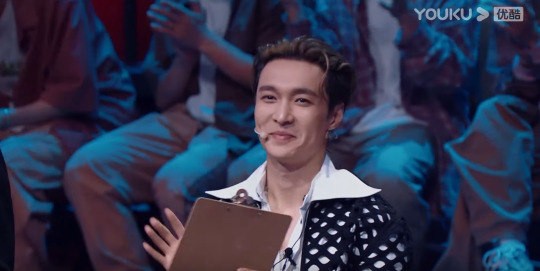
- Lmao Xiao Jie said that Xiaohai was the good luck charm of their team XD His good luck charm name is Jr. Baby, aka Haibaobao lol
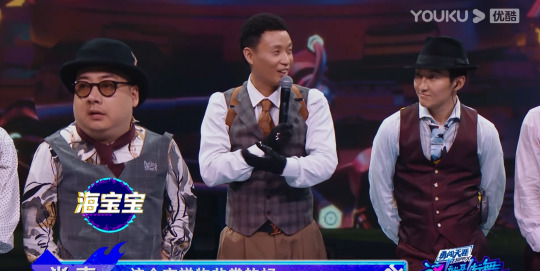
- Yibo and Yixing voted for Gogo Brothers, and Han Geng voted for AC, so Henry, who had two votes, had the final say in who would win this battle. Then we got the theatrics where Han Geng, Yibo, and Yixing went into the audience because their job was done lol.

- Then Henry was like “ge~~~~ didn’t you say you would take care of me?” And Han Geng’s like, I’m letting you have the SDOC experience bro.
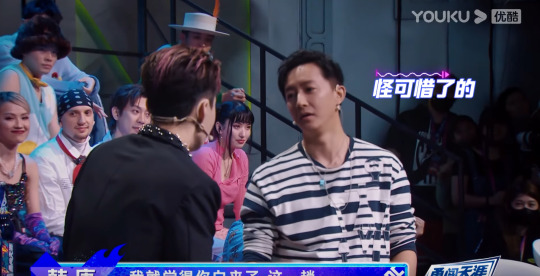
- Even though we all know it’s a joke, Han Geng is still so caring and affectionate lol.
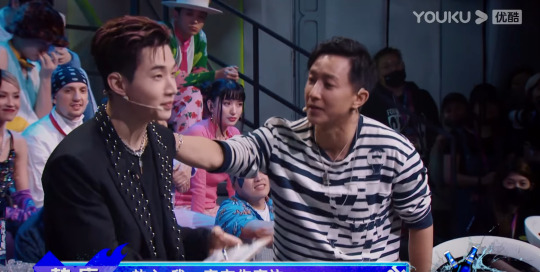
- Anyway, after all that shenaniganery, what Henry said was right. It feels so tough eliminating any single member of the team, because it was all of them who helped deliver such a beautiful performance. I know AC had a tough time going up against Gogo brothers but dammit I actually super loved their performance. So cruel!!!!!
- Han Geng felt bad because Auju had said he wanted to be in a solo battle in the 3 vs 3 challenge, but he was put in the 5 vs. 5 battle and then this group performance, so Han Geng wanted to let him have the stage to perform his best. I thought it was a nice gesture, to let him have the stage to show off in the way he was most confident with, to let himself show himself at his best.
- Then Henry was like “what if we had Auju AND Yixing????”
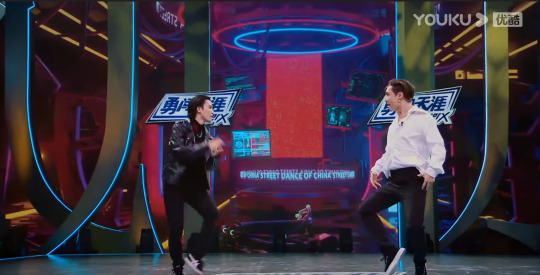
- And then Boi Marble joined!!! Krumptastic
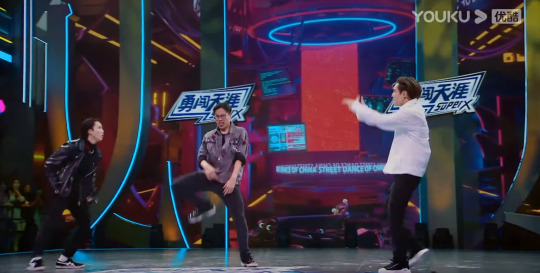
- Yixing said that even though krumpers look really fierce, that aside from the krump, all of them are lil cuties uwu.
- Team Nelson having fun with Hanfu was so cute! :D Sometimes with the non-Chinese contestants, I worry that they find the Chinese culture stuff tedious, because SDOC does try to fit as much culture in. So I’m glad to see that they’re at least finding a way to have fun. I wish I had such pretty hanfu to dress up in v.v
- I’ll be honest though, I don’t think Nelson’s team was very synchronized. He had a lot of very good individual dancers (Bouboo, Zyko, Lil Kev, that firepower is undeniable), but there were parts when I felt like all of the dancers were doing their own thing. Maybe the choreography was too subtle, or maybe the dancers themselves had slightly different rhythms.
- Acky-san giving red pockets to his team, but instead of money, he wrote them letters in different languages T_T
- A full popping team is risky move, but it paid off. Everybody was popping so everybody was dancing to their strength. Compare that to some of the other teams, where there were some dancers who clearly were lagging because they were dancing to a style they were very comfortable with. In addition, the visual style of the performance was fresh and fun. Their costumes were very wacky and fun to look at, and their performance exuded the kind of fun vibes where you felt like you wanted to join them.
- Out of the captains who’d lost their challenges, they would have to battle each other in a round robin style tournament. First place would get to keep two of their "pending” members, and second place would get to keep one.
- Yixing got up SO FAST when Tell Me started playing. I didn’t know this song before so I looked it up and it is a bop haha.
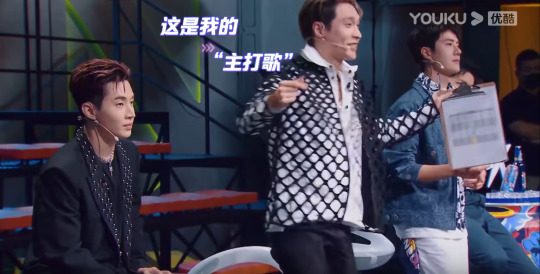
- Yixing dancing along uwu I don’t know the name of this song but it was the second song in the Ibuki vs. Liangliang battle.
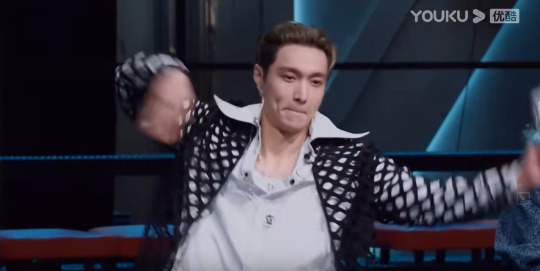
- AC vs. Ibuki dancing to It’s Raining Men was A LOT of fun, particularly because everybody including the spectators knew the song haha.
- The first place winner was Nelson who was able to save Tengzai and Lil Kev and the second place winner was AC who could only choose one person to save, and AC chose Fanfan.
- Ma Xiaolong and Huang Xiao comforting Ibuki because she couldn’t save her team members :(
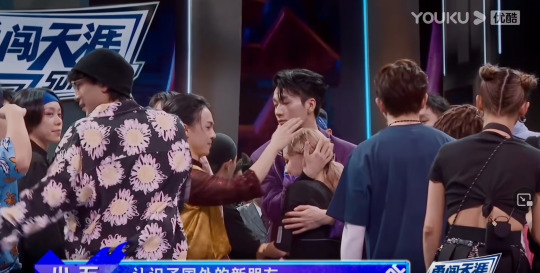
- Ahh I’m going to miss Yuri because she was so cute and fun. AC apologized for not being able to save her :( Gonna miss u bb ;(


- I liked Latrice too T_T Hated to see her go :(
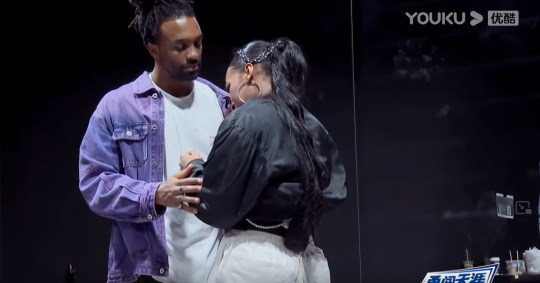
- Brats playing with the microphones. They basically disassembled their standing microphones and waved the part around even after Han Geng already told Yibo not to lmao.
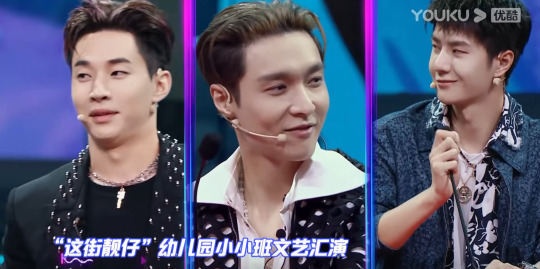
- So this section was supposed to be the captains’ opportunity to tell the dancers what kind of team they were looking to put together. Yixing was so surprised because Han Geng and Yibo had very simple and short statements (though it took a while for Han Geng to get to his point), because the boy deadass prepared a speech. Of course he did.
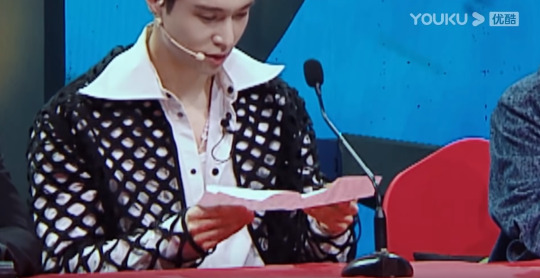
- Yang Kai said that his speech sounded like a motivational speech from a boss at work. That’s exactly what it is.
- Apparently Henry also prepared a speech XD

- So from what I understand, the captains will recruit a team that they think represents their style. Afterwards, the dancers who have not been chosen will get to choose their team based on which captain’s style they like. I think that’s how it works, we’ll see if I’m right lol.
- Henry trying to gleam information X3 Yibo just deals with the pressure by smiling and shaking his head. Dare I say this is the first time I’ve seen Yibo look shy??????? It’s cuuuute.


- Since the cubicles don’t have ceilings, Henry was like someone could be watching me!

- Nosy housecat in training
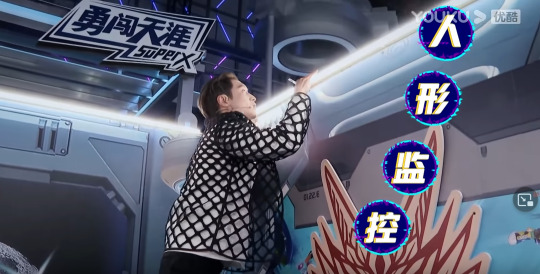
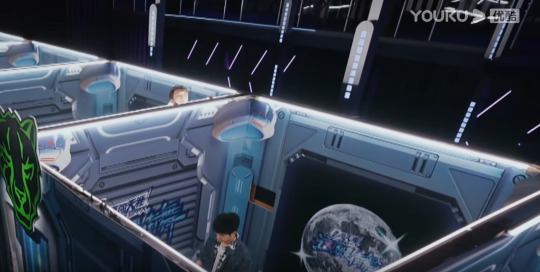
- Yibo and Henry and Han Geng were playing mind games being like “oh, you picked Poppin’C? And Yixing fell for the trick ^^;; Luckily he was not allowed to change his answer so at least he’s not going to make a change he regrets lol.
- All of the dancers Yixing picked were not picked by anyone else so he was quite lucky.
- Han Geng had three of his choices matching with Henry or Yibo.

- Henry has no idea how to recruit dancers so he just ends up singing love songs. Of course.
- Zyko’s loyal dude XD I can see why Han Geng is a safe choice though. Han Geng is low on the theatrics, so if I was a low key guy like Zyko, I’d probably feel less pressure being on his team. I could just focus on dance and not on entertaining the cameras.
- I can see why Nelson would go with Yibo. Yibo is quiet but he’s serious and focused and more importantly they both confirmed that they are competitors.
- Henry and Han Geng both chose Ibuki. Here Han Geng is patiently waiting/spying while Ibuki and Henry have their interview.
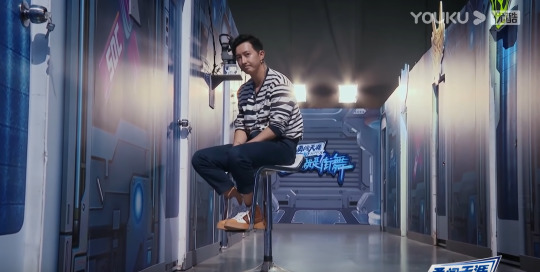
- Then he was offered a ladder and Geng-ge became the biggest gremlin lmao.

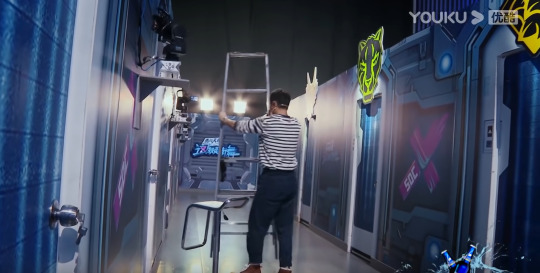
- Yixing the good little helper.
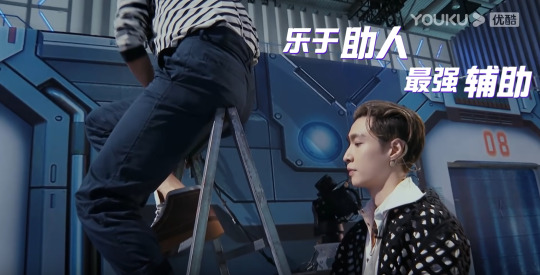
- C U T I E

- When Han Geng was having his interview with Ibuki, he locked the ladder in his own room and kept the key. Then he stole the keys from all the other rooms and gave them to Henry XD Actual troll-ge.
- Ibuki chose Han Geng in the end.
- So all of the people Henry chose picked other captains. This frame lmfao.
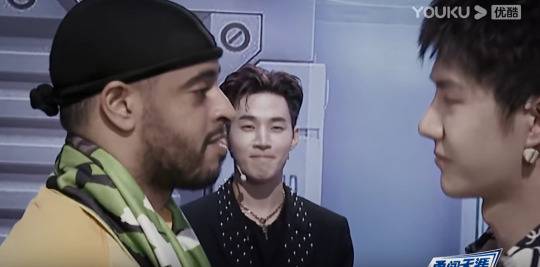
- I think last season Yixing had tons of trouble recruiting dancers to his team. In the hotpot preview he said he was super lax about this year and it worked in his favour.
5 notes
·
View notes
Text
The Evolution of “It’s You”
To be honest, I’m pretty sure “It’s You” was the first SJ song I went absolutely feral on, because the beat is so damn catchy, and best of all, it’s a SAD BOP!
If you’ve ever wanted a sad dance track with emotional vibes about how even after a breakup, the one in their heart will always be you (we appreciate a gender neutral love song), then this is the one.
youtube
“It’s You” holds a special place for being the last MV that all thirteen members are involved in. It also is the song that SJ was promoting while Kibum was taking a step back from singing (Kibum doesn’t have lines and is missing from promo activities because he was already pivoting to acting at this point in time) and Han Geng was filing his lawsuit. Super turbulent times in 2009.
I was going through all the different live performances of “It’s You” for nostalgia’s sake during these social distancing hours, and I was kinda punched in the gut at how much this song means to me as an ELF. I literally took an eight-year break from following anything k-pop related, yet somehow I ended back here, with Super Junior, as a full-ass adult. I’ve grown to love all the other parts of SMTown and a bunch of other groups and artists, but SJ will always be the one for me, no matter what (okay if anyone pulls something like seungri did they’re dead to me).
"It’s You” really highlights not only SJ’s versatility, but also their growth. Super Junior’s gone through so many line-up changes over the years, and no matter what version of the line distribution and choreo they perform, “It’s You” just continues to develop like fine wine. (How is this song ELEVEN YEARS OLD)
Come through under the cut for the masterlist of performance videos, what stood out to me about each of them, and to experience the evolution yourself! :)
ALSO - please send me song requests for more “Evolution of ___” type posts bc it’s just so much fun to see how performances change and age
SBS Inkigayo (May 17th, 2009)
youtube
The first performance of “It’s You”. Ever.
Donghae’s opening vocals were sooo iffy (especially if Ryeowook or Kyuhyun were juxtaposed in the verse right after) back in the day, it’s wild - but also have the time you gotta ask whether he was sick at the time or not smh
ELF are already serving the fan chant sing-along when the song had barely been out for a week - iconic, given the fact that you literally had to buy or pirate in 2009 bc streaming wasn’t a thing
What is Leeteuk’s ponytail
I miss the simplicity of 2nd gen choreo - like the whole vibe of this was “we’re going to move to the beat and make it very obvious via formation who is singing a verse/chorus (giant hint, it’s the center)”
Dance line’s (read: Eunhyuk and Shindong’s) chest pops hitting everyone in the feels - oh wait WTF this camera completely cuts off Eunhyuk and Shindong’s chest pop duet
2009 Eunhyuk and Shindong, don’t worry, your suave vocals will come soon, just give it a few more years
Yesung’s ad-lib solos during the last chorus were done standing up and off to the side - just wait for the the drama to escalate in later performances folks
Music Core (May 30, 2009)
(I’m maxing out on the number of embedded videos so click the header for the link)
Not much different from the one above, just better camera angles and resolution, and the first(?) time Yesung does his ad-lib solos while kneeling on the floor, bc you gotta add some d r a m a
Music Core (June 6, 2009)
(Once again, click above for the link)
Don’t really know whether this one or the performance right below came first
But Han Geng is MIA bc of...Reasons™, so Siwon takes over his opening ad-libs
Yesung’s face has a blankness to it during his verse, which is just so sad; usually he has an aura of confidence but it was completely not there during this at all (literally just compare directly to the performance above and it’s SO different)
Leeteuk’s awkwardly like smiling during his verse? (It comes off like he’s trying too hard to make it look like things are fine) But it’s not his usual camera expression so you just know something is wrong
Ironically this is probably the stablest Eunhyuk’s vocals have been during 2009 for his line
It’s really obvious that Yesung is struggling to keep it together emotionally for this performance like good god, he’s really been blank-slating a lot of this performance
And then Heechul has to come in looking depressed as fuck (which is hella valid) for his solo and nails it (while looking like his cat died - long live han j(ae) heebum)
Siwon and Yesung bump into each other as they get into the ending pose
God I really could say more about how each member performs as they cope with this but I’ll refrain
Music Core (Sometime later, 2009)
(Once again, click above for the link)
Hella sad times because Hangeng is notably missing right from the get-go again, with Yesung taking his opening ad-libs
Also Kangin is missing but I cannot remember why - kudos to Sungmin for covering (but idk why he was trying so hard to sound raspier like Kangin bc that did not work for him)
Imagine having to rearrange all the formations and reassign parts to promote on a regular music show because you’re missing two whole members
Correction, THREE whole members because Heechul was so emotionally fucked up from Hangeng leaving
Kudos to Leeteuk for being that Bitch and delivering on Heechul’s solo
Like, this was the peak of 2009 turmoil for SJ
At least Yesung had some (angry) spark in him for this performance bc I would not be able to handle another sad/blank performance from him (that shit hurted ok)
This whole performance has a simultaneous sense of muted solemnity and (angry/petulant) fighting spirit to it bc they’re all trying real hard to compartmentalize the shit that’s happening outside of this stage
I think the phrase is more like “y’all think this shit is going to break us, but it’s not” which once again goes along with the whole “SJ is a bunch of veterans that will keep going on even if the road is barren/till the end of the line” concept that they’ve painted for themselves
Super Show 5 - Seoul (2013, no 83line)
youtube
The Super Show DVDs give such superior sound quality (infinitely better when listened to with headphones). You can really hear the distinct timbre among all their voices.
eunhyuk what are those glasses/shindong what is that hair
congrats to dance/rap line on their vocal growth !!
Leeteuk and Heechul were off in the military during SS5, which means that Ryeowook and Kyuhyun got to take over Heechul’s mid-song solo. (I honestly don’t think I would have survived had Ryeowook done the ending of that part, because he has the type of voice that pierces through your heart)
yesung going feral during his solo on the platform is everything tbh
Super Show 5 - Osaka (2013, no Yesung)
youtube
It’s the same tour, so most aspects of the performance are the same. Yesung’s absence (due to mandatory service) led to some interesting change-ups, namely:
Sungmin taking his first verse with his fresh clear vocals
Heechul pulling a Heechul, appearing on the platform and then promptly disappearing - king of GHOSTING
Ryeowook being in charge of the SCREAM solo. KRY have completely different timbres, and Ryeowook’s take on this solo gives a very different feel.
Yesung’s known for having the more soulful voice, whereas Ryeowook executes in a clearer manner that comes off as more technical/didactic way
KRY comeback next month guys it’s COMING
Super Show 7 - Seoul (2017)
youtube
(You’re gonna have to jump to 3:30 bc this is a 2-in-1 vid)
SS7 brought this hit back in a completely new way.
The blindfolds, guys... p l e a s e.
The original choreo relied a lot on the number of members. Even though the choreography has completely changed, and there’s only half the number of members, the song still hits.
Once again, not shutting up about how much Eunhyuk’s vocals have improved. Like...he really was out here during the 8th album/SS7 and taking over main vocal lines. He’s developed so much control over his voice, and the result we hear is a honey-sweet smooth timbre.
Chest pop dance break reinvented but still referencing the dance line duet
You barely notice when Siwon covers Kangin’s lines and Leeteuk covers Sungmin’s during the second verse, bc this time around they actually picked members with similar timbres (i am still ?? at why sungmin tried to emulate kangin’s voice to the point where it messed up his own verse during that 2009 performance)
Shindong leading a chorus, did 2009 us ever see this coming
The fact that Yesung finally does his kneeling scream solo smack in center sends
#super junior#suju#elf#kpop#leeteuk#heechul#hangeng#kangin#yesung#shindong#sungmin#eunhyuk#donghae#siwon#ryeowook#kibum#kyuhyun#kylie speaks#am i seriously starting to become a kpop thoughts blog? who knows#when i say 'SJ's like cockroaches' i mean it with respect because this is the only group that could survive doomsday together#evolution of super junior#am i gonna do more of these? probably - what else is there for me to do during social distancing hours#suju crash courses
5 notes
·
View notes
Text
Ochungulo Family is a More Ethical Ethic
Yeah I said it.
I was initially afraid this statement might be a bit classist coming from me, a middle class suburb bred 20-something year old. But the genre has risen from its gritty hood predecessor, ‘genge’ and moved up the street into the Boiler Room co-signed Jason Dunford aka Samaki Mkuu spitting ‘gengetone’.
https://www.youtube.com/watch?v=A4jko8AHWIU
Did Ethic walk so that Ochungulo Family could fly?
If so, then the Kansoul crawled so that Ethic could take it’s stumbling baby steps into the receiving arms of the Nairobi mass market. Meaning Jua Cali and Jimwaat swam like sperm to egg so that the Kansoul, 2 lads from the cabro streets of Ridgeways with the sole exception of Mtoto wa Khadija, Mejja who gives the Kansoul it’s much needed mtaa edge, would be accepted by both the clipped english accents of Capital FM and the tongue chewing sheng of Ghetto Radio.
Now that the scene has burst open like the ripe fruit it is, there’s so many of them: Boondocks Gang, Zero Sufuri, Sailors. The question I’m not going to answer today is “When did Gengetone stop being snubbed by Naija-blaring establishments and became the flag-waving sound of the nation it is today?
The question I WILL answer today is: What’s the difference between Ochungulo Family and Ethic that makes the former a boy band of insinuating heart throbs, and the latter cancelled by KoT?
Perhaps a brief history of both camps is in order. Let’s start with Ethic.
These kids broke out of the precinct of Umoja and into the scene with the finger-licking club banger, ‘Lamba Lolo’ back in 2018, stirring a country-wide frenzy. The beat is a simple repetitive stock synth melody backed by the easiest bassline. The low-budget music video shot in their neighbourhood features REKLES, SWAT, SESKA and ZILLA on what seems like a regular weekend dusk, where they called their friends out to come jam- the bottles and cups ubiquitous in hip hop music videos swapped for Big Boms and Pin Pops.
Analogy: If Ethic is Pin Pop. Ochungulo is Chupa Chup.
It’s clear from the jump that REKLES is the most lyrically adept, with SWAT’s notoriety stemming from being the cutest face. The track isn’t so much a wine and dine as it is a ‘let’s skip to the good bits’ as it’s opening line states, “Piga Goti (eeh) Panua Domo basi (eeh)” with a chorus that repeats the question, “Ushailamba lolo?”
Browsing through their discography, their second single ‘Postion’ was a smash hit with the co-sign of the Kansoul, providing us listeners with beloved catch phrases such as ‘Geuka Nikubeng’ ‘Ganja Farmer ni wale wajanja’ ‘Ushaiguswa uskie tu kunyora ushaiguswa uskie tu kuoga’ and of course, ‘shuglibagli shugblibagli nden nden nden nden.” One of the laziest verses of Okonkwo’s career in my opinion but I digress.
So now let’s jump to their 3 most controversial tracks, ‘Pandana’ ‘Tarimbo’ and ‘Soko’.
In ‘Pandana’, the phrase that came under fire was Rekles’ use of the word ‘Tunabakana’ ; Baka meaning rape in kiswahili. However with Rekless use, ‘tunabakana’ translates to ‘we are raping each other,’ a double non-consent which cancels each other out and alludes to consent. While rape in any construct or form should not be encouraged, this line may have been taken out of context by KoT. Rekles probably meant no harm in its use, simply suggesting that they are aggressively in each other’s body business. However from this faux pas, Rekles should have learned. He did not.
In Tarimbo, less innocently, he raps, “Mi huchapa mi humwaga hata bila permission” One thing should be clear, doing anything to anyone’s body bila permission is non-consent aka sexual assault. This lyric can not be as easily forgiven.
It gets harder and harder to defend these guys with ‘Soko’, which Rekles opens with the line, ‘Kuna toto na ameiva iza’ ‘There’s a child and she’s ripe sorry’ bringing to our moral imagination the fact that the object of this rhyme is a minor. Contrast this with SWAT’s badly interpreted line in ‘Pandana’ where he says ‘Toto yako iyeke fiti nitaikulala’ and you can see that the use of the word ‘toto’ in each of these songs is different. In ‘Pandana’, SWAT uses toto as a euphemism for lady parts. In ‘Soko’. Rekles’ toto is an underaged girl. While both are lewd, Pandana is suggestive whereas Soko is criminal.
Speaking of criminal, let’s dive into Ochungulo family and compare see whether they’re anymore saintlike or if we’re a public who ignore dirty things if they’re dressed clean.
https://twitter.com/ethicofficial/status/1270784205308526593
This is the tweet that started this whole investigation. Ochungulo broke out with the Nelly the goon led track, “Bora Uhai’ an ode to life and all it’s sweetness. Followed shortly thereafter by ‘Krimino’ and a rain of smash hit singles following the likes of ‘Na Iwake’ ‘Aluta’ ‘Kaa Na Mamayako’ where Alejandro Chief Inspekta compared thee’s nipples to a nectarine blossoming flower’s in the less shakespearean format. “Nipple zako nazinyonya kama nectar’
Alejandro Chief Inspekta aka Benzema, formerly EDM producer with the electronic collective Lectronica Circle has found more success and notoriety and ease in the world of gengetone than in Dance Music. Already, gritty grimy gengetone and synthesized programmed European Dance Music are contrasted by a class divide. You won’t hear Martin Garrix being introduced by Mbonoko on the radio during your work day commute. Only the middle classed suburb youth had fantasies of jet setting to Tomorrowland with their pocket money savings.
More specifically diving into the track in question, ‘Ngwatiology’. ‘Ngwati’ being sheng for porn hence ngwatiology meaning ‘a deep analysis of the effects of pornography on the human psyche through a thorough hand-genital exploration’ Masturbation folks.
While hilariously lewd, there’s no foul play in ‘Ngwatiology’ just a play by play of the natural phenomenon that is ngwatiology.
“Did you know porn hub awards, hu-happen once, ile time ya cramps?”
“Did you know arsenal fans? Hao hukuwa ass-anal fans?”
In conclusion, yes. Ochungulo Family are the more ethical ethic. While both teams are explicit, straight-to-the-point, no-beat-around -the-bush-just-beat-this-meat when it comes to the content of their lyrics, there’s a line in the distant horizon that cannot be crossed. And the name of that line is consent. Ethic have crossed that line whereas Ochungulo Family have not. This does not make any better or worse than the other. In today’s morally policed jungle, both bands are prey and Ezekiel ‘Pornstache’ Mutua is the predator sending cringe emails to Youtube like an uncle who still doesn’t understand how the internet works.
#kenyan music#kenya#kenyan#music blogging#music blog#play ke music#ochungulo family#ethic entertainment#genge#gengetone#jason dunford#samaki mkuu#kansoul#the kansoul
1 note
·
View note
Text
Music Genres

This is a list of some of the world's music genre and their definitions.
African Folk - Music held to be typical of a nation or ethnic group, known to all segments of its society, and preserved usually by oral tradition.
Afro jazz - Refers to jazz music which has been heavily influenced by African music. The music took elements of marabi, swing and American jazz and synthesized this into a unique fusion. The first band to really achieve this synthesis was the South African band Jazz Maniacs.
Afro-beat - Is a combination of Yoruba music, jazz, Highlife, and funk rhythms, fused with African percussion and vocal styles, popularized in Africa in the 1970s.
Afro-Pop - Afropop or Afro Pop is a term sometimes used to refer to contemporary African pop music. The term does not refer to a specific style or sound, but is used as a general term to describe African popular music.
Apala - Originally derived from the Yoruba people of Nigeria. It is a percussion-based style that developed in the late 1930s, when it was used to wake worshippers after fasting during the Islamic holy month of Ramadan.
Assiko - is a popular dance from the South of Cameroon. The band is usually based on a singer accompanied with a guitar, and a percussionnist playing the pulsating rhythm of Assiko with metal knives and forks on an empty bottle.
Batuque - is a music and dance genre from Cape Verde.
Bend Skin - is a kind of urban Cameroonian popular music. Kouchoum Mbada is the most well-known group associated with the genre.
Benga - Is a musical genre of Kenyan popular music. It evolved between the late 1940s and late 1960s, in Kenya's capital city of Nairobi.
Biguine - is a style of music that originated in Martinique in the 19th century. By combining the traditional bele music with the polka, the black musicians of Martinique created the biguine, which comprises three distinct styles, the biguine de salon, the biguine de bal and the biguines de rue.
Bikutsi - is a musical genre from Cameroon. It developed from the traditional styles of the Beti, or Ewondo, people, who live around the city of Yaounde.
Bongo Flava - it has a mix of rap, hip hop, and R&B for starters but these labels don't do it justice. It's rap, hip hop and R&B Tanzanian style: a big melting pot of tastes, history, culture and identity.
Cadence - is a particular series of intervals or chords that ends a phrase, section, or piece of music.
Calypso - is a style of Afro-Caribbean music which originated in Trinidad at about the start of the 20th century. The roots of the genre lay in the arrival of African slaves, who, not being allowed to speak with each other, communicated through song.
Chaabi - is a popular music of Morocco, very similar to the Algerian Rai.
Chimurenga - is a Zimbabwean popular music genre coined by and popularised by Thomas Mapfumo. Chimurenga is a Shona language word for struggle.
Chouval Bwa - features percussion, bamboo flute, accordion, and wax-paper/comb-type kazoo. The music originated among rural Martinicans.
Christian Rap - is a form of rap which uses Christian themes to express the songwriter's faith.
Coladeira - is a form of music in Cape Verde. Its element ascends to funacola which is a mixture of funanáa and coladera. Famous coladera musicians includes Antoninho Travadinha.
Contemporary Christian - is a genre of popular music which is lyrically focused on matters concerned with the Christian faith.
Country - is a blend of popular musical forms originally found in the Southern United States and the Appalachian Mountains. It has roots in traditional folk music, Celtic music, blues, gospel music, hokum, and old-time music and evolved rapidly in the 1920s.
Dance Hall - is a type of Jamaican popular music which developed in the late 1970s, with exponents such as Yellowman and Shabba Ranks. It is also known as bashment. The style is characterized by a deejay singing and toasting (or rapping) over raw and danceable music riddims.
Disco - is a genre of dance-oriented pop music that was popularized in dance clubs in the mid-1970s.
Folk - in the most basic sense of the term, is music by and for the common people.
Freestyle - is a form of electronic music that is heavily influenced by Latin American culture.
Fuji - is a popular Nigerian musical genre. It arose from the improvisation Ajisari/were music tradition, which is a kind of Muslim music performed to wake believers before dawn during the Ramadan fasting season.
Funana - is a mixed Portuguese and African music and dance from Santiago, Cape Verde. It is said that the lower part of the body movement is African, and the upper part Portuguese.
Funk - is an American musical style that originated in the mid- to late-1960s when African American musicians blended soul music, soul jazz and R&B into a rhythmic, danceable new form of music.
Gangsta rap - is a subgenre of hip-hop music which developed during the late 1980s. 'Gangsta' is a variation on the spelling of 'gangster'. After the popularity of Dr. Dre's The Chronic in 1992, gangsta rap became the most commercially lucrative subgenre of hip-hop.
Genge - is a genre of hip hop music that had its beginnings in Nairobi, Kenya. The name was coined and popularized by Kenyan rapper Nonini who started off at Calif Records. It is a style that incorporates hip hop, dancehall and traditional African music styles. It is commonly sung in Sheng(slung),Swahili or local dialects.
Gnawa - is a mixture of African, Berber, and Arabic religious songs and rhythms. It combines music and acrobatic dancing. The music is both a prayer and a celebration of life.
Gospel - is a musical genre characterized by dominant vocals (often with strong use of harmony) referencing lyrics of a religious nature, particularly Christian.
Highlife - is a musical genre that originated in Ghana and spread to Sierra Leone and Nigeria in the 1920s and other West African countries.
Hip-Hop - is a style of popular music, typically consisting of a rhythmic, rhyming vocal style called rapping (also known as emceeing) over backing beats and scratching performed on a turntable by a DJ.
House - is a style of electronic dance music that was developed by dance club DJs in Chicago in the early to mid-1980s. House music is strongly influenced by elements of the late 1970s soul- and funk-infused dance music style of disco.
Indie - is a term used to describe genres, scenes, subcultures, styles and other cultural attributes in music, characterized by their independence from major commercial record labels and their autonomous, do-it-yourself approach to recording and publishing.
Instrumental - An instrumental is, in contrast to a song, a musical composition or recording without lyrics or any other sort of vocal music; all of the music is produced by musical instruments.
Isicathamiya - is an a cappella singing style that originated from the South African Zulus.
Jazz - is an original American musical art form which originated around the beginning of the 20th century in African American communities in the Southern United States out of a confluence of African and European music traditions.
Jit - is a style of popular Zimbabwean dance music. It features a swift rhythm played on drums and accompanied by a guitar.
Juju - is a style of Nigerian popular music, derived from traditional Yoruba percussion. It evolved in the 1920s in urban clubs across the countries. The first jùjú recordings were by Tunde King and Ojoge Daniel from the 1920s.
Kizomba - is one of the most popular genres of dance and music from Angola. Sung generally in Portuguese, it is a genre of music with a romantic flow mixed with African rhythm.
Kwaito - is a music genre that emerged in Johannesburg, South Africa in the early 1990s. It is based on house music beats, but typically at a slower tempo and containing melodic and percussive African samples which are looped, deep basslines and often vocals, generally male, shouted or chanted rather than sung or rapped.
Kwela - is a happy, often pennywhistle based, street music from southern Africa with jazzy underpinnings. It evolved from the marabi sound and brought South African music to international prominence in the 1950s.
Lingala - Soukous (also known as Soukous or Congo, and previously as African rumba) is a musical genre that originated in the two neighbouring countries of Belgian Congo and French Congo during the 1930s and early 1940s
Makossa - is a type of music which is most popular in urban areas in Cameroon. It is similar to soukous, except it includes strong bass rhythm and a prominent horn section. It originated from a type of Duala dance called kossa, with significant influences from jazz, ambasse bey, Latin music, highlife and rumba.
Malouf - a kind of music imported to Tunisia from Andalusia after the Spanish conquest in the 15th century.
Mapouka - also known under the name of Macouka, is a traditional dance from the south-east of the Ivory Coast in the area of Dabou, sometimes carried out during religious ceremonies.
Maringa - is a West African musical genre. It evolved among the Kru people of Sierra Leone and Liberia, who used Portuguese guitars brought by sailors, combining local melodies and rhythms with Trinidadian calypso.
Marrabenta - is a form of Mozambican dance music. It was developed in Maputo, the capital city of Mozambique, formerly Laurenco Marques.
Mazurka - is a Polish folk dance in triple meter with a lively tempo, containing a heavy accent on the third or second beat. It is always found to have either a triplet, trill, dotted eighth note pair, or ordinary eighth note pair before two quarter notes.
Mbalax - is the national popular dance music of Senegal. It is a fusion of popular dance musics from the West such as jazz, soul, Latin, and rock blended with sabar, the traditional drumming and dance music of Senegal.
Mbaqanga - is a style of South African music with rural Zulu roots that continues to influence musicians worldwide today. The style was originated in the early 1960s.
Mbube - is a form of South African vocal music, made famous by the South African group Ladysmith Black Mambazo. The word mbube means "lion" in Zulu
Merengue - is a type of lively, joyful music and dance that comes from the Dominican Republic
Morna - is a genre of Cape Verdean music, related to Portuguese fado, Brazilian modinha, Argentinian tango, and Angolan lament.
Museve - is a popular Zimbabwe music genre. Artists include Simon Chimbetu and Alick Macheso
Oldies - term commonly used to describe a radio format that usually concentrates on Top 40 music from the '50s, '60s and '70s. Oldies are typically from R&B, pop and rock music genres.
Pop - is an ample and imprecise category of modern music not defined by artistic considerations but by its potential audience or prospective market.
Quadrille - is a historic dance performed by four couples in a square formation, a precursor to traditional square dancing. It is also a style of music.
R&B - is a popular music genre combining jazz, gospel, and blues influences, first performed by African American artists.
Rai - is a form of folk music, originated in Oran, Algeria from Bedouin shepherds, mixed with Spanish, French, African and Arabic musical forms, which dates back to the 1930s and has been primarily evolved by women in the culture.
Ragga - is a sub-genre of dancehall music or reggae, in which the instrumentation primarily consists of electronic music; sampling often serves a prominent role in raggamuffin music as well.
Rap - is the rhythmic singing delivery of rhymes and wordplay, one of the elements of hip hop music and culture.
Rara - is a form of festival music used for street processions, typically during Easter Week.
Reggae - is a music genre first developed in Jamaica in the late 1960s. A particular music style that originated following on the development of ska and rocksteady. Reggae is based on a rhythm style characterized by regular chops on the off-beat, known as the skank.
Reggaeton - is a form of urban music which became popular with Latin American youth during the early 1990s. Originating in Panama, Reggaeton blends Jamaican music influences of reggae and dancehall with those of Latin America, such as bomba, plena, merengue, and bachata as well as that of hip hop and Electronica.
Rock - is a form of popular music with a prominent vocal melody accompanied by guitar, drums, and bass. Many styles of rock music also use keyboard instruments such as organ, piano, synthesizers.
Rumba - is a family of music rhythms and dance styles that originated in Africa and were introduced to Cuba and the New World by African slaves.
Salegy - is a popular type of Afropop styles exported from Madagascar. This Sub-Saharan African folk music dance originated with the Malagasy language of Madagascar, Southern Africa.
Salsa - is a diverse and predominantly Spanish Caribbean genre that is popular across Latin America and among Latinos abroad.
Samba - is one of the most popular forms of music in Brazil. It is widely viewed as Brazil's national musical style.
Sega - is an evolved combination of traditional Music of Seychelles,Mauritian and Réunionnais music with European dance music like polka and quadrilles.
Seggae - is a music genre invented in the mid 1980s by the Mauritian Rasta singer, Joseph Reginald Topize who was sometimes known as Kaya, after a song title by Bob Marley. Seggae is a fusion of sega from the island country, Mauritius, and reggae.
Semba - is a traditional type of music from the Southern-African country of Angola. Semba is the predecessor to a variety of music styles originated from Africa, of which three of the most famous are Samba (from Brazil), Kizomba (Angolan style of music derived directly from Zouk music) and Kuduro (or Kuduru, energetic, fast-paced Angolan Techno music, so to speak).
Shona Music - is the music of the Shona people of Zimbabwe. There are several different types of traditional Shona music including mbira, singing, hosho and drumming. Very often, this music will be accompanied by dancing, and participation by the audience.
Ska - is a music genre that originated in Jamaica in the late 1950s and was a precursor to rocksteady and reggae. Ska combined elements of Caribbean mento and calypso with American jazz and rhythm and blues.
Slow Jam - is typically a song with an R&B-influenced melody. Slow jams are commonly R&B ballads or just downtempo songs. The term is most commonly reserved for soft-sounding songs with heavily emotional or romantic lyrical content.
Soca - is a form of dance music that originated in Trinidad from calypso. It combines the melodic lilting sound of calypso with insistent (usually electronic in recent music) percussion.
Soukous - is a musical genre that originated in the two neighbouring countries of Belgian Congo and French Congo during the 1930s and early 1940s, and which has gained popularity throughout Africa.
Soul - is a music genre that combines rhythm and blues and gospel music, originating in the United States.
Taarab - is a music genre popular in Tanzania. It is influenced by music from the cultures with a historical presence in East Africa, including music from East Asia, Sub-Saharan Africa, North Africa, the Middle East and Europe. Taarab rose to prominence in 1928 with the rise of the genre's first star, Siti binti Saad.
Tango - is a style of music that originated among European immigrant populations of Argentina and Uruguay. It is traditionally played by a sextet, known as the orquesta típica, which includes two violins, piano, doublebass, and two bandoneons.
Waka - is a popular Islamic-oriented Yoruba musical genre. It was pioneered and made popular by Alhaja Batile Alake from Ijebu, who took the genre into the mainstream Nigerian music by playing it at concerts and parties; also, she was the first waka singer to record an album.
Wassoulou - is a genre of West African popular music, named after the region of Wassoulou. It is performed mostly by women, using lyrics that address women's issues regarding childbearing, fertility and polygamy.
Ziglibithy - is a style of Ivorian popular music that developed in the 1970s. It was the first major genre of music from the Ivory Coast. The first major pioneer of the style was Ernesto Djedje.
Zouglou - is a dance oriented style of music from the Côte d'Ivoire (Ivory Coast) that first evolved in the 1990s. It started with students (les parents du Campus) from the University of Abidjan HasenChat Music.
Zouk - is a style of rhythmic music originating from the French islands of Guadeloupe and Martinique. It has its roots in kompa music from Haiti, cadence music from Dominica, as popularised by Grammacks and Exile One.
3 notes
·
View notes
Text
DEBRIEFING: 27 November 2021 | Brooklyn, NY | TREVORSHAUS

There’s a lot of wires...trying to clear my space… Trapped in a communal identity. Cannibal Ox’s “Pigeon” blares. Vast Aire tesseract-stares through space and time: “In this frigid, fragile capsule, / That allows you to fly south before the winter winds trap you.” Somewhere on the borderline between Bushwick and Bed-Stuy, where “FTP” chalks the sidewalk and “ACAB” is Kryloned cursively across the street. The girders of the elevated tracks running above Broadway are bombed-out. (We were under the underground.) Better days behind; better days ahead. Where was I, some temporary autonomous zone? Circle-A commune stylings, and intentions are always messy, but collective effort inspires. An altar of prayer candles and sigils, zines and incense. We don’t really need altars, is what my money clip of small bills reads. Legal tender. Cowrie shells. Coat drive for the cold, chilled to the bone. (Make noise for the clothes on your back, AKAI SOLO implores.) The whiff of Obama incense: “Somewhere between Saturday night and Sunday morning. / You want it all, but it can’t save you.” ELUCID was Black Herman in the fugue state, hoodoo headaching. I fight the night just to save the day, Dreamcrusher sighs, suspires [from below + breathe] nihilistically, queerly. Fertile is a feeling, and this seemed like a hovel where’ing those flowers grow. Rose from concrete. Four Skinny Trees from the sidewalk slabs of Mango Street. (Avocado prices going up…) “When the seeds from the trees of the bounty not fruitful.” AKAI throaty with his raps through nebulae, ibliss at his back. Blackout of ’77. Arson fires and gentrifiers. No gentle fires. Hyssop sneaks through the cracks. God speed, you Black emp-ruh. Didn’t someone once say we’re trapped in the belly of this horrible machine, and the machine is bleeding to death? Did I hear wrong? The sun has fallen down. “The Masters Clock is X”, a concerto in X minor. Control’s an illusion. He’s Sonnet 29 howling, and “screaming in the void only gave [him] a sore throat.” And trouble deaf heaven with his bootless cries. You don’t have to be here if you don’t wanna. I wanna. Smoke ’em if you got ’em, the Hunter urged. Centennial Gardens, quite contrary. How does your garden grow? From Dreamcrusher: “I love when nature takes over, like when shrubs and bushes climb buildings...pictures of centuries-old structures completely taken by nature.” For Geng, it’s about “intentionally inviting our people to challenging tradition in the journey—never to alienate…. a familiar place of love & spirit & energy.” Dreamcrusher’s menagerie of musks wafts and KING VISION ULTRA’s nub of Palo Santo glows in the gossamer of smoke. [...trying to clear my space…] And then you hear the anvil snares and glass-cutter percussion. Love, love, love, love, love. [WE MOVE WITH LOVE!] Scuzzed and fuzzy. Diaphragm-damaged goodness. [IT’S STILL WILD LOVE!] “You can fathom it—I trust you.” Prison doors creak. Metal grinds. Blades sharpen on grindstone. “There’s no room for de-vi-a-tion!” Mic pass to Fatboi Sharif bladdered on coconut vodka, crying out, “Mass abundance, / Kidnapped in the dungeon.” He speaks of epochs ending, every time. He is a zeitgeist, a duppy deading us instantaneously. [SELF-ACTUALIZATION!] The most baleful and beautiful bassline there’s ever been: Wu-Tang’s “Clan in Da Front,” which samples The New Birth’s 1971 psychedelic soul smite “Honeybee.” Here, tempo slowed, drug through the gutter. Like a mouthful (a godawful maw-full) of bees, the swarming ribcage of Tony Todd. Our bodies buzzing. The toilet seat had only one working hinge, and I expected a honeycomb when I pinned back the lid. The pit! In the pit we were all pendulum’d from side to side. It was sick—sick unto death with that long agony. AKAI SOLO summoned back: he shrieks. Dreamcrusher steps into beyond. “Take off my mask, baby, and see what I’ve become. SEE WHO I’VE BECOME!!!” What is this Precious Silence before H31R? The nanosecond before JWords plugs into the aux. No signal loss. The signal flare is tossed. “You can’t put your spirit on sale,” maassai says. Donations only in this space. Pay what you can. “You just wanna take my big spirit, throw it in a flame.” Sacrificial. Take a hold of the person next to you and sway to JWords’ squealing winds. We | will | not | tolerate | beating, | lynching, | burning, | whipping, | pillaging, | torturing, or “toxic behavior” of any kind. maassai warns those who “wanna wear [her] like a face.” Semiratruth leads the call-and-response, ritual and the rawest democratizing of voices: “MY GAWD.” I be disassociating… Hard to maintain my om mantra. Don’t believe me? Just watch my chakras. Omicron circulates in our consciousness, transmitting over planetary currents. I caught a case of the Covid creeps [I caught the vapors...vapors...vapors...] with mucosa on my backpack which I had set on the floor, blunt smoke permeating the fibers of my layered fur. Walls closing in. “To be the norm—not to be normalized,” followed by a primal scream Janovian yowl. Noise that cuts like metal burrs. Brrr, it was brick, and the weather outside was frightful. First snowfall of the season speculations, but I didn’t see even a dusting on the New Jerusalem side of the Hudson. SILENT WEAPONS. Been killarmy’d. Silent Weapons for Dirty Wars: the top secret programming manual, “uncovered quite by accident” in 1986. A Boeing employee purchased a surplus IBM copier for scrap parts and “discovered inside details of a plan, hatched in the embryonic days of the ‘Cold War’ which called for control of the masses through manipulation...diverting the public’s attention from what’s really going on.” The original doc insidious, of course, but the proliferation of the text (found in a copier!) a gift to the people. A tape dub. The weather in Brooklyn dropped to near-freezing. Feeling frigid like Vordul Mega’s “Eskimo metal.” I felt I was under siege of sound, listening to Black visionaries bringing war like revolutionaries. I heard drunk and deadly poetry over murderous melodies. AKAI says to make melody out of this mess. Yes.




Photo credits: caltrops. | Detail of “Silent Weapons” flyer design by Dreamcrusher
0 notes
Text
Afrobeats Update #5: Gengetone (April 2021)
#gengetone#afrobeats#afropop#genge#genge rap#kenya music#kemusic#playkemusic#kenyan music#afro rap#afro hip hop#afrorap#afrohiphop#dancehall#mixtape#mixtapes
1 note
·
View note
Text
MMC Geng – Kpormegbe ft. Robikyn, Joey Da Gaboy, Jwusu & Golden Boy
MMC Geng – Kpormegbe ft. Robikyn, Joey Da Gaboy, Jwusu & Golden Boy
Ghanaian music collective MMC Geng is making strides to becoming one of the influential creative hub in the Ghanaian music space. Consistent with their music releases, MMC Geng serves a new number titled ‘Kpormegbe’, an Ewe word which means ‘Watch Your Back’ in literal terms. The captivating tune enlists Robikyn, Joey Da Gaboy, Jwusu and Golden Boy for the eclectic mix of impressive rap…

View On WordPress
0 notes